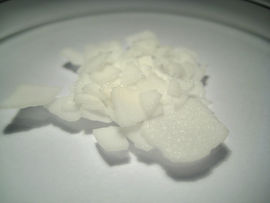Difference between revisions of "Resorcinol"
(Created page with "{{Chembox | Name = | Reference = | IUPACName = | PIN = | SystematicName = | OtherNames = <!-- Images --> | ImageFile = | ImageSize = | ImageAlt = | ImageName = | ImageFil...") |
|||
| (3 intermediate revisions by 2 users not shown) | |||
| Line 1: | Line 1: | ||
{{Chembox | {{Chembox | ||
| − | | Name = | + | | Name = Resorcinol |
| Reference = | | Reference = | ||
| − | | IUPACName = | + | | IUPACName = Benzene-1,3-diol |
| PIN = | | PIN = | ||
| SystematicName = | | SystematicName = | ||
| OtherNames = | | OtherNames = | ||
| + | 1,3-Benzenediol<br>1,3-Dihydroxybenzene<br>3-Hydroxyphenol<br>m-Benzenediol<br>m-Dihydroxybenzene<br>m-Hydroquinone<br>Resorcin | ||
<!-- Images --> | <!-- Images --> | ||
| − | | ImageFile = | + | | ImageFile = Resorcinol.jpg |
| − | | ImageSize = | + | | ImageSize = 270 |
| ImageAlt = | | ImageAlt = | ||
| ImageName = | | ImageName = | ||
| + | | ImageCaption = Sample of resorcinol | ||
| ImageFile1 = | | ImageFile1 = | ||
| ImageSize1 = | | ImageSize1 = | ||
| Line 90: | Line 92: | ||
| AutoignitionPt = 608 °C (1126 °F; 881 K) | | AutoignitionPt = 608 °C (1126 °F; 881 K) | ||
| ExploLimits = | | ExploLimits = | ||
| − | | ExternalMSDS = [] | + | | ExternalMSDS = [https://www.docdroid.net/9v6IKWW/resorcinol-sa.pdf Sigma-Aldrich] |
| FlashPt = 127 °C (260.6 °F; 400 K) | | FlashPt = 127 °C (260.6 °F; 400 K) | ||
| LD50 = | | LD50 = | ||
| Line 105: | Line 107: | ||
| OtherFunction = | | OtherFunction = | ||
| OtherFunction_label = | | OtherFunction_label = | ||
| − | | OtherCompounds = [[Phenol]] | + | | OtherCompounds = [[Phenol]]<br>[[Phloroglucinol]] |
}} | }} | ||
}} | }} | ||
| − | '''Resorcinol''' (or '''resorcin''') is an organic compound with the formula '''C<sub>6</sub>H<sub>4</sub>(OH)<sub>/2<sub>'''. | + | '''Resorcinol''' (or '''resorcin''') is an organic compound with the chemical formula '''C<sub>6</sub>H<sub>4</sub>(OH)<sub>/2<sub>'''. |
==Properties== | ==Properties== | ||
| Line 114: | Line 116: | ||
Resorcinol reduces [[Fehling's solution]] and [[Tollens' reagent|ammoniacal silver solutions]]. | Resorcinol reduces [[Fehling's solution]] and [[Tollens' reagent|ammoniacal silver solutions]]. | ||
| − | When fused with potassium hydroxide, resorcinol yields phloroglucin. | + | When fused with [[potassium hydroxide]], resorcinol yields phloroglucin. |
When resorcinol is mixed with [[sodium nitrite]], a water-soluble blue dye, which is turned red by acids, and is used as an [[PH indicator|indicator]], under the name of lacmoid. | When resorcinol is mixed with [[sodium nitrite]], a water-soluble blue dye, which is turned red by acids, and is used as an [[PH indicator|indicator]], under the name of lacmoid. | ||
Latest revision as of 19:52, 25 October 2020
 Sample of resorcinol
| |
| Names | |
|---|---|
| IUPAC name
Benzene-1,3-diol
| |
| Other names
1,3-Benzenediol
1,3-Dihydroxybenzene 3-Hydroxyphenol m-Benzenediol m-Dihydroxybenzene m-Hydroquinone Resorcin | |
| Properties | |
| C6H6O2 C6H4(OH)/2 | |
| Molar mass | 110.1 g/mol |
| Appearance | White solid |
| Odor | Faint, characteristic aromatic odor |
| Density | 1.28 g/cm3 |
| Melting point | 110 °C (230 °F; 383 K) |
| Boiling point | 277 °C (531 °F; 550 K) |
| 110 g/100 ml at 20 °C | |
| Solubility | Soluble in acetone, carbon tetrachloride, diethyl ether, DMSO, ethanol, glycerol, isopropanol, methanol Insoluble in benzene, carbon disulfide, chloroform |
| Vapor pressure | 0.0002 mmHg (25 °C) |
| Acidity (pKa) | 9.30 11.06 |
| Thermochemistry | |
| Hazards | |
| Safety data sheet | Sigma-Aldrich |
| Flash point | 127 °C (260.6 °F; 400 K) |
| Related compounds | |
| Related compounds
|
Phenol Phloroglucinol |
| Except where otherwise noted, data are given for materials in their standard state (at 25 °C [77 °F], 100 kPa). | |
| Infobox references | |
Resorcinol (or resorcin) is an organic compound with the chemical formula C6H4(OH)/2.
Contents
Properties
Chemical
Resorcinol reduces Fehling's solution and ammoniacal silver solutions.
When fused with potassium hydroxide, resorcinol yields phloroglucin.
When resorcinol is mixed with sodium nitrite, a water-soluble blue dye, which is turned red by acids, and is used as an indicator, under the name of lacmoid.
Nitration with concentrated nitric acid in the presence of cold concentrated sulfuric acid (nitrating mixture) yields trinitro-resorcin (styphnic acid), an explosive.
Physical
Resorcinol is a white crystalline solid that becomes pink on exposure to light and air.
Availability
Resorcinol is sold by chemical suppliers.
Some over-the-counter topical acne treatments contain 2% resorcinol.
Preparation
Resorcinol is produced in several steps from benzene, starting with dialkylation with propylene to give 1,3-diisopropylbenzene. Oxidation and Hock rearrangement of this disubstituted arene gives acetone and resorcinol.
Projects
- Make dyes
- Make pH indicator
- Make styphnic acid
Handling
Safety
Resorcinol is irritant and should be handled with care. In large amounts is toxic, and can be absorbed through skin.
Storage
In closed bottles.
Disposal
Should be diluted with water and poured down the drain.
References
Relevant Sciencemadness threads
- Resorcinol synthesis
- Synthesis of Resorcinol
- extract resorcinol from hair dye
- Possible route to resorcinol from Tylenol / Paracetamol?
- resorcinol from salicilic acid?